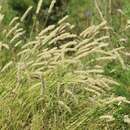Comments
provided by eFloras
This is a tall, robust species with a showy, dense panicle of large, papery spikelets. It is closely related to the E Asian Melica turczaninowiana by its spikelet structure and by the strongly scabrid abaxial surface of the leaf blade. However, the two species are completely different in panicle structure.
- license
- cc-by-nc-sa-3.0
- copyright
- Missouri Botanical Garden, 4344 Shaw Boulevard, St. Louis, MO, 63110 USA
Description
provided by eFloras
Perennial, loosely tufted, with long creeping rhizomes. Culms 50–150 cm tall, 2–3 mm in diam. Leaf sheaths scabrid on veins; leaf blades flat, thin, 10–20 cm × 4–12 mm, abaxial surface strongly scabrid on veins, adaxial surface smooth; ligule 2–5 mm. Panicle linear-oblong in outline, very dense with many crowded spikelets, interrupted below, 10–20 cm, 1-sided; branches erect, appressed to main axis, up to 5 cm. Spikelets broadly elliptic to obovate, 10–14 mm, fertile florets 2(or 3), terminal sterile lemmas gathered into globular cluster; glumes dark purple or white at maturity, oblanceolate-oblong to ovate, subequal, 7–11 mm, papery, 5–7-veined with connecting veinlets, both acute or obtuse; lemmas oblanceolate-oblong, lowest 8–11 mm, 7-veined, additional intermediate veins in lower half, scaberulous, apex obtuse, acute or minutely mucronate; palea 2/3 lemma length, keels ciliolate. Anthers 1.8–2.5 mm. Fl. and fr. Jun–Aug. 2n = 18.
- license
- cc-by-nc-sa-3.0
- copyright
- Missouri Botanical Garden, 4344 Shaw Boulevard, St. Louis, MO, 63110 USA
Distribution
provided by eFloras
Xinjiang [Kazakhstan, Kyrgyzstan, Russia, Tajikistan, Uzbekistan; SW Asia (Caucasus, N Iran), C and E Europe].
- license
- cc-by-nc-sa-3.0
- copyright
- Missouri Botanical Garden, 4344 Shaw Boulevard, St. Louis, MO, 63110 USA
Physical Description
provided by USDA PLANTS text
Perennials, Terrestrial, not aquatic, Rhizomes present, Rhizome elongate, creeping, stems distant, Stems nodes swollen or brittle, Stems erect or ascending, Stems caespitose, tufted, or clustered, Stems terete, round in cross section, or polygonal, Stem internodes hollow, Stems with inflorescence less than 1 m tall, Stems, culms, or scapes exceeding basal leaves, Leaves mostly basal, below middle of stem, Leaves mostly cauline, Leaves conspicuously 2-ranked, distichous, Leaves sheathing at base, Leaf sheath mostly closed, Leaf sheath smooth, glabrous, Leaf sheath and blade differentiated, Leaf blades linear, Leaf blades 2-10 mm wide, Leaf blades 1-2 cm wide, Leaf blades mostly flat, Leaf blade margins folded, involute, or conduplicate, Leaf blades mostly glabrous, Leaf blades scabrous, roughened, or wrinkled, Ligule present, Ligule an unfringed eciliate membrane, Inflorescence terminal, Inflorescence an open panicle, openly paniculate, branches spreading, Inflorescence solitary, with 1 spike, fascicle, glomerule, head, or cluster per stem or culm, Inflorescence lax, widely spreading, branches drooping, pendulous, Inflorescence branches more than 10 to numerous, Flowers bisexual, Spikelets pedicellate, Spikelets laterally compressed, Spikelet less than 3 mm wide, Spikelets with 2 florets, Spikelets solitary at rachis nodes, Spikelets all alike and fertille, Spikelets bisexual, Spikelets disarticulating below the glumes, Rachilla or pedicel glabrous, Glumes present, empty bracts , Glumes 2 clearly present, Glumes equal or subequal, Glumes shorter than adjacent lemma, Glumes equal to or longer than adjacent lemma, Glumes 3 nerved, Glumes 4-7 nerved, Lemma coriaceous, firmer or thicker in texture than the glumes, Lemma 5-7 nerved, Lemma 8-15 nerved, Lemma glabrous, Lemma rugose, with cross wrinkles, or roughened, Lemma apex truncate, rounded, or obtuse, Lemma awnless, Lemma margins thin, lying flat, Lemma straight, Palea present, well developed, Palea membranous, hyaline, Palea shorter than lemma, Palea 2 nerved or 2 keeled, Palea keels winged, scabrous, or ciliate, Stamens 3, Styles 2-fid, deeply 2-branched, Stigmas 2, Fruit - caryopsis, Caryopsis ellipsoid, longitudinally grooved, hilum long-linear.
Melica altissima: Brief Summary
provided by wikipedia EN
Melica altissima, commonly known as Siberian melic grass or dark purple Siberian melic, is a species of plant in the grass family, Poaceae.
It has been naturalized in North America, in Ontario, Oklahoma and New York.
- license
- cc-by-sa-3.0
- copyright
- Wikipedia authors and editors

